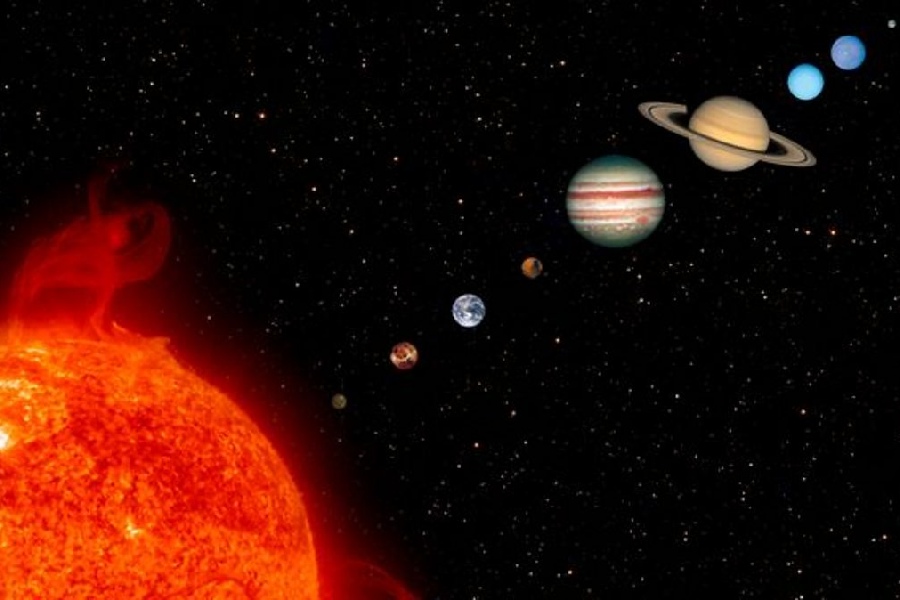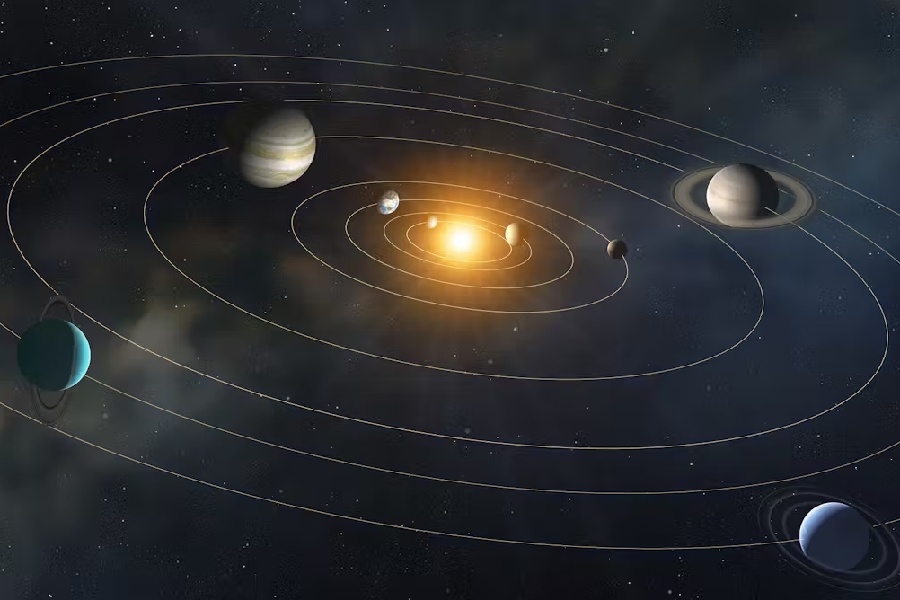When we gaze up at the night sky, many of us wonder about the other worlds out there. One fascinating question that arises is whether seasons exist on planets besides Earth. So, which planets have seasons? And which planet has the most extreme seasons?
In this article, we’ll explore the concept of planetary seasons and uncover which celestial bodies experience this cyclical phenomenon. As we dive into this topic, we’ll discover the intricate dance of axial tilts and orbital paths that govern seasonal patterns across the cosmic landscape.
Surprisingly, some realms within our Solar System and beyond defy our earthly expectations. They challenge our preconceived notions about the nature of seasons.
Join us on this interplanetary journey as we venture through our solar system and beyond. One should be prepared to have their cosmic perspectives shifted in ways they never imagined.

Which Planets Have Seasons?
Several planets in our Solar System experience seasons. Earth, Mars, Uranus, Neptune, and Pluto all have noticeable seasonal changes. Earth has distinct seasons because of its axial tilt.
Mars has longer seasons because its tilt is about 25.2 degrees. Jupiter and Saturn have minimal tilts, so their changes are subtle.
Moreover, Uranus has extreme seasons because it tilts 98 degrees, leading to prolonged sunlight and darkness at its poles. Neptune’s tilt causes moderate seasonal variations.
Pluto, classified as a dwarf planet, also experiences seasons because of its significant tilt. Yet, they’re less noticeable because of the distance from the Sun and the thin atmosphere.
But which planets have no seasons? Mercury and Venus have no seasons due to their lack of axial tilt relative to the plane of their orbits around the Sun.
Understanding seasonal changes
The tilt of a planet’s rotational axis relative to its orbital plane around the star is the primary cause of seasons. As a planet orbits, different parts receive direct or oblique sunlight due to this axial tilt, resulting in variations in solar energy received.
The extent of axial tilt influences the severity of seasonal changes. Earth has a 23.5-degree tilt, causing distinct seasons across hemispheres, with longer days and more direct sunlight in summer.
As mentioned, Mars has a 25.2-degree tilt, leading to variations in temperature, atmosphere, and polar ice caps. Neptune’s 28.3-degree tilt causes seasons comparable to Earth’s but lasting over 40 Earth years due to its elongated orbit.
Earth and Its Seasons
The Earth’s seasonal cycle, consisting of spring, summer, autumn, and winter, happens because the planet tilts consistently at 23.5 degrees in relation to the Sun. This tilt exposes different parts of the Earth to varying amounts of sunlight throughout the year.
In the Northern Hemisphere, spring begins with warmer weather and longer days, leading to summer peak temperatures around the June solstice. As daylight decreases toward the equinox, temperatures cool down during autumn.
Winter brings the coldest temperatures and shortest days in the Northern Hemisphere around the December solstice when that part of the Earth is tilted away from the Sun’s direct rays. Also, Earth’s slightly elliptical orbit causes minor variations in the seasons.
But which planet has seasons like Earth? As you continue reading, we’ll discuss planets with no seasonal changes and those with seasons like Earth’s.
Seasonal variations in the Northern and Southern Hemispheres
The Northern and Southern Hemispheres’ seasons mirror images due to Earth’s axial tilt. When the Northern Hemisphere experiences summer, it has longer days, more direct sunlight, and higher temperatures.
Meanwhile, the Southern Hemisphere experiences winter with shorter days, oblique sunlight, and colder temperatures as the South Pole tilts away from the Sun. Conversely, summer in the Southern Hemisphere coincides with winter in the Northern Hemisphere.
While seasonal characteristics remain similar, the primary difference lies in their timing. One hemisphere’s summer occurs during the other’s winter due to the axial tilt and Earth’s orbit around the Sun.

Other Planets in Our Solar System That Have Seasons
In our Solar System, the dance of celestial bodies isn’t limited to Earth alone. Several planets and even some dwarf planets experience their own unique versions of seasons, influenced by factors such as axial tilt, orbit shape, and atmospheric dynamics.
But do other planets have seasons like Earth? While other planets in our Solar System do experience seasons, they vary significantly from those on Earth due to differences in axial tilt, orbit shape, and atmospheric composition.
Mercury and Venus: Closest to the Sun
Mercury, the closest planet to the Sun, does not experience traditional seasons like those on Earth. This is due to its negligible 0.03-degree axial tilt and highly elliptical orbit.
However, it exhibits extreme temperature variations between day and night. During its 88-day year, certain areas receive intense solar radiation, causing “hot seasons” up to 800 °F (427° C). At night, these same regions plunge to around -290 °F (-179 °C) during prolonged “cold seasons”.
Like Mercury, Venus does not undergo seasonal changes throughout its year due to its minimal 2.6-degree axial tilt and nearly circular orbit. Instead, Venus experiences uniform temperatures averaging 864 °F (462 °C) year-round. This is due to its dense atmosphere trapping heat from the Sun, resulting in a constant, scorching summer.
Mars: A Red Planet with severe conditions
Mars experiences seasonal changes akin to those on Earth. But with far more extreme conditions due to its 25.2-degree axial tilt and elliptical orbit around the Sun. During the Martian southern hemisphere’s summer, the planet encounters intense, global-scale dust storms.
These storms can engulf it for weeks or months, fueled by increased solar heating stirring up surface dust. Martian seasons also bring drastic temperature swings. Equatorial regions reach 70 °F (20° C) in summer but plunge to -195 °F (-125 °C) in winter.
Poles range from -20 °F (-29 °C) in summer to -195 °F (-125 °C) in winter. Additionally, Mars’ polar ice caps are composed of frozen carbon dioxide and undergo significant changes.
They partially sublimate in spring and summer before reforming in fall and winter as temperatures drop. These harsh seasonal conditions pose challenges for potential future human exploration and habitation on the Red Planet.
Jupiter: A gas giant with varying distance from the Sun
Jupiter, the largest planet in our Solar System, exhibits unique seasonal characteristics. These characteristics are influenced by its slightly elliptical orbit and atmospheric composition. Jupiter’s distance from the Sun varies throughout its 12-year orbit.
Perihelion, the closest point, receives more intense solar radiation, contributing to warmer atmospheric temperatures. Aphelion, the farthest point, experiences relatively cooler conditions.
Jupiter’s gaseous atmosphere plays a role, with the Great Red Spot storm tending to intensify and grow larger during periods of increased solar heating. Additionally, Jupiter’s colorful cloud bands undergo seasonal changes.
They become more prominent and vibrant during increased solar radiation. These changes occur due to atmospheric circulation patterns and chemical reactions. Studying these seasonal aspects enhances our understanding of gas giants in our Solar System and beyond.
Saturn: A ringed planet with a tilted axis of rotation
Saturn’s 26.7-degree tilted axis plays a crucial role in shaping its seasons. Due to this tilt, different latitudes experience varying levels of solar exposure throughout Saturn’s nearly 30-year orbital period.
Increased solar heating fuels stronger circulation patterns and more intense storms in the respective summer hemisphere. Conversely, the winter hemisphere experiences relative calm. Plus, Saturn’s iconic rings contribute to seasonal variations.
The rings appear brighter when the illuminated side faces the Earth and darker when the non-illuminated side is visible. These seasonal changes are driven by Saturn’s axial tilt of 26.7 degrees and its 29.5-year orbit around the Sun.
Uranus and Neptune: Outermost planets with binary stars
Uranus and Neptune experience seasons quite unlike those on Earth due to their extreme axial tilts. Uranus is tilted almost completely on its side, causing it to orbit the sun like a rolling ball.
This leads to decades-long seasons lasting around 21 years each. These seasons exhibit extreme variations in sunlight exposure. Neptune’s 28° tilt results in even longer seasons, and each one lasts over 40 years in its 165-year orbit.
Both planets have binary companions. Uranus’ large moons, Oberon and Titania, form a binary dwarf planet system. Neptune’s captured moon, Triton, is a binary partner over 1/3 the size of Earth’s moon.
These binary setups influence tidal forces and orbital resonances and may have shaped the planets’ evolution over time. The tilts also drive intense winds, with Neptune hosting the Solar System’s fastest at over 1,600 km/h (roughly 994 mph).
Conclusion
So, which planets have seasons? The study of planetary seasons unveils a rich tapestry of celestial rhythms across our Solar System and beyond.
While Earth’s seasons are familiar to us, each planet presents its own unique variation influenced by factors such as axial tilt, orbit shape, and atmospheric dynamics. From the extreme tilt of Uranus leading to decades-long seasons to the subtle variations on Jupiter influenced by its distance from the Sun, the diversity of seasonal patterns in our cosmic neighborhood is truly remarkable.
Exploring these seasonal phenomena deepens the understanding of planetary dynamics. It also broadens the perspectives on the vastness and complexity of the cosmos.
